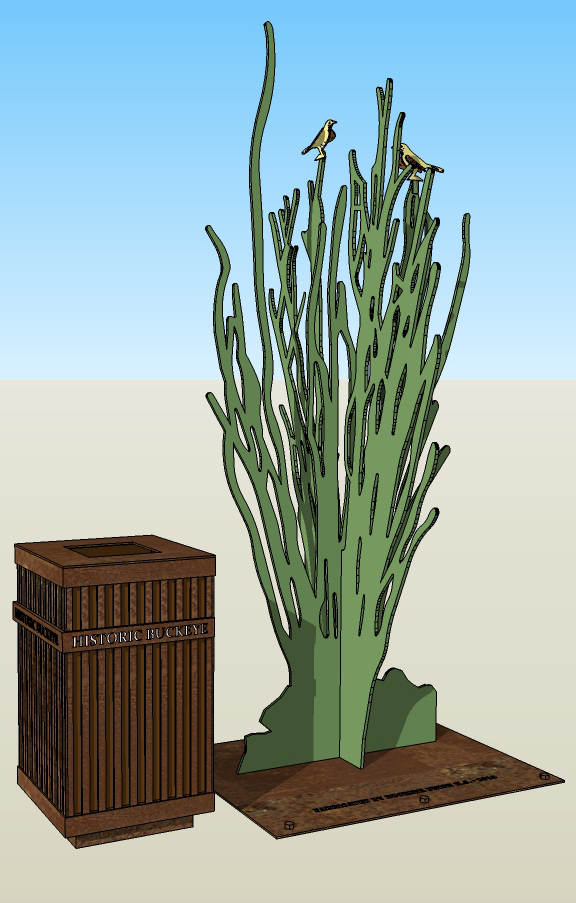
by Jeff Serbin | Jun 15, 2018 | Blog, Collaboration, Graphics, phoenix architects, public art, sculpture, Uncategorized
Frequently, Serbin Studio gets pulled away from the design of commercial building to design Public art. Whether designing a building or a sculpture, a similar process is involved. Conceptual design of various renditions are created for the Buckeye Main Street Coalition (entity in charge of creating the art), once a direction is selected, construction documentation is developed. The plans created are submitted to the city for permitting.
The art is a continuation of the sculptures found in Downtown Buckeye previously designed, fabricated and installed near Buckeye City Hall. That originally involved 4 sculptures that included a tractor, a cowboy roper, a cowgirl barrel racer and a cotton boll. www.serbinstudio.com/public-works/
Art Description
This projects consist of sculptures fabricated from sheets of steel. The prior sculptures were slightly larger and required their own footings. This time, our design intent was to design sculptures that would not require the expense of a large concrete footing. Two of the sculptures are 8′ tall so the effect known as Cantilever – “rigid structural element, such as a beam or a plate, anchored at one end” created a requirement for the sculptures to be stiff enough to allow for bending forces created from the occasional monsoon wind gust. This pushed the steel thickness to 3/4″.
A 4′ X 8′ sheet of steel at 3/4″ thick is approx. 1K LBS. This created another fabrication challenge. Fabrication, maneuvering them around the shop and shop fabrication or cutting of the steel. Once the sculptures were cut, powder coating would wrap the steel in the desired color.
The location of the sculptures are at 4th street and Monroe in Downtown Historic Buckeye. If you know the history of Buckeye, this intersection was the main cross streets of a Town that was the thoroughfare from downtown Phoenix to San Diego up to the early 1970’s. Now I-10 bypasses this quite town, but recently, the town is in its early stages of revival.
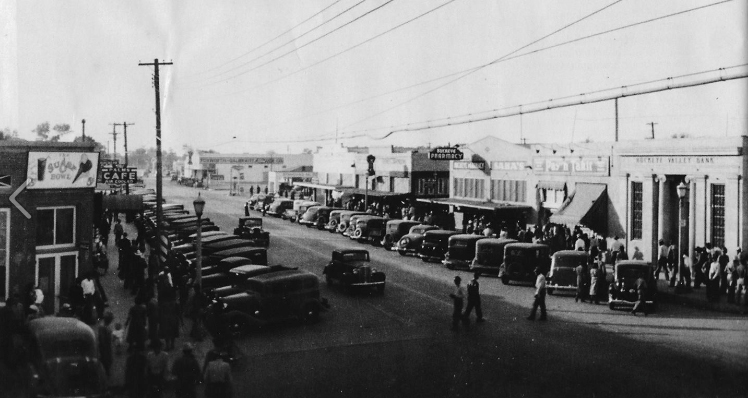
Downtown Buckeye in the 1930’s. It was a busy time back then.
The sculptures are located at the 4 corners of Monroe and 4th street. They reference the local fauna and flora of Arizona.
The Saguaro and ocotillo are going to be fabricated by the Arizona Corrections. The Barrel and Prickly cactus will be fabricated by the Buckeye High School Metal shop.
Art Presentation Graphics
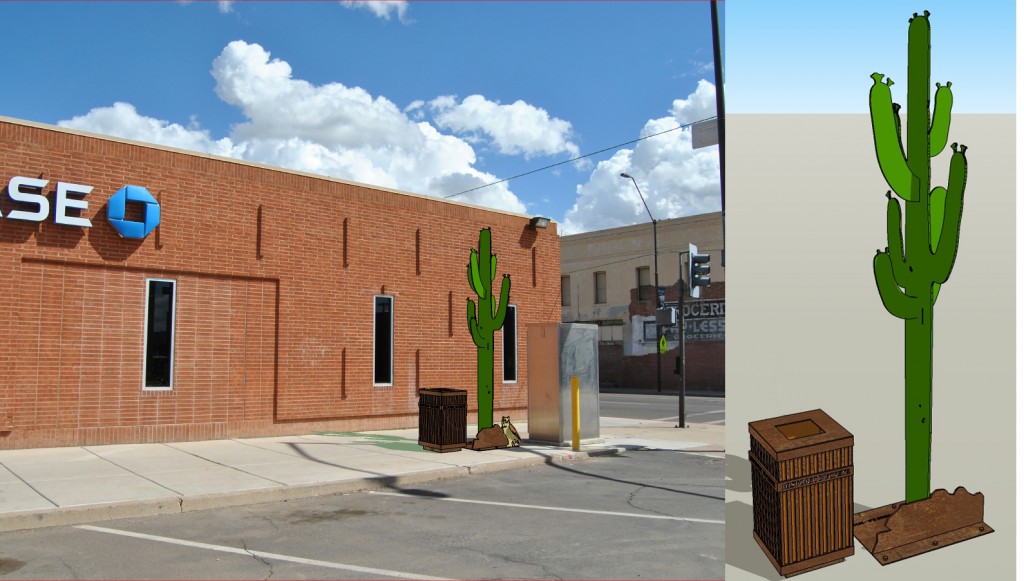
Saguaro located at Northeast corner of Monroe and 4th Street
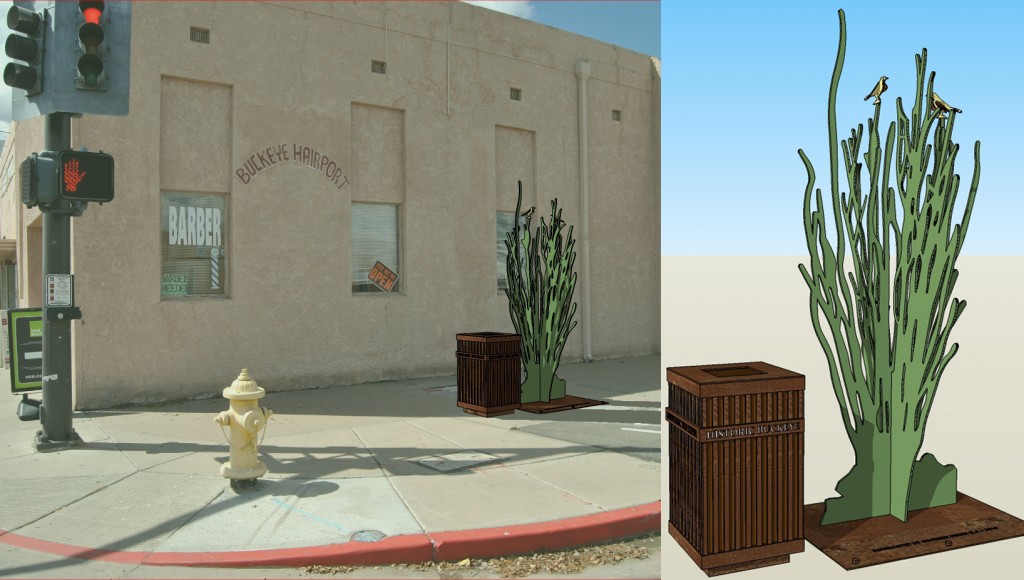
ocotillo located at NorthWest corner of Monroe and 4th Street
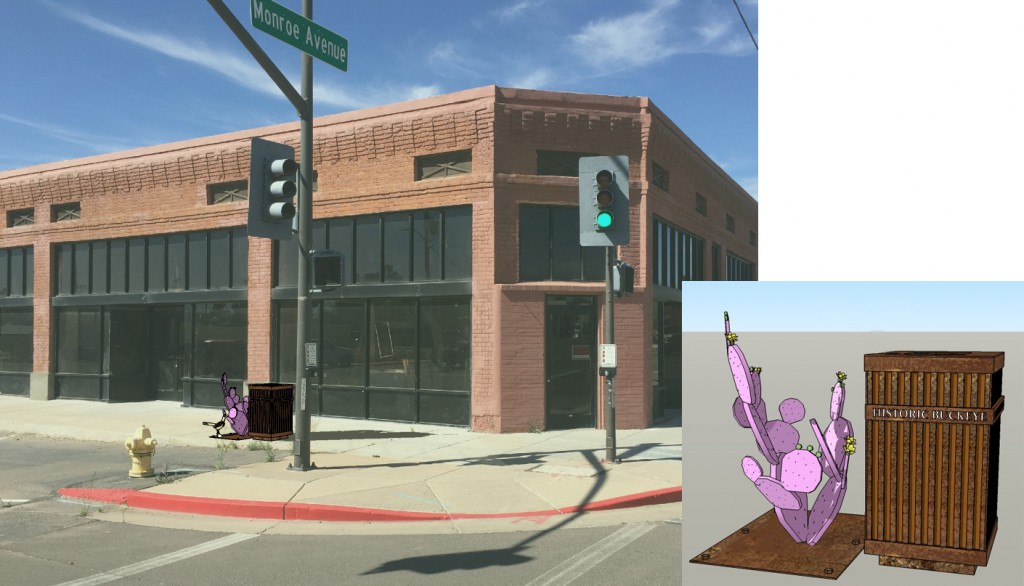
Prickly Pear located at SouthWest corner of Monroe and 4th Street
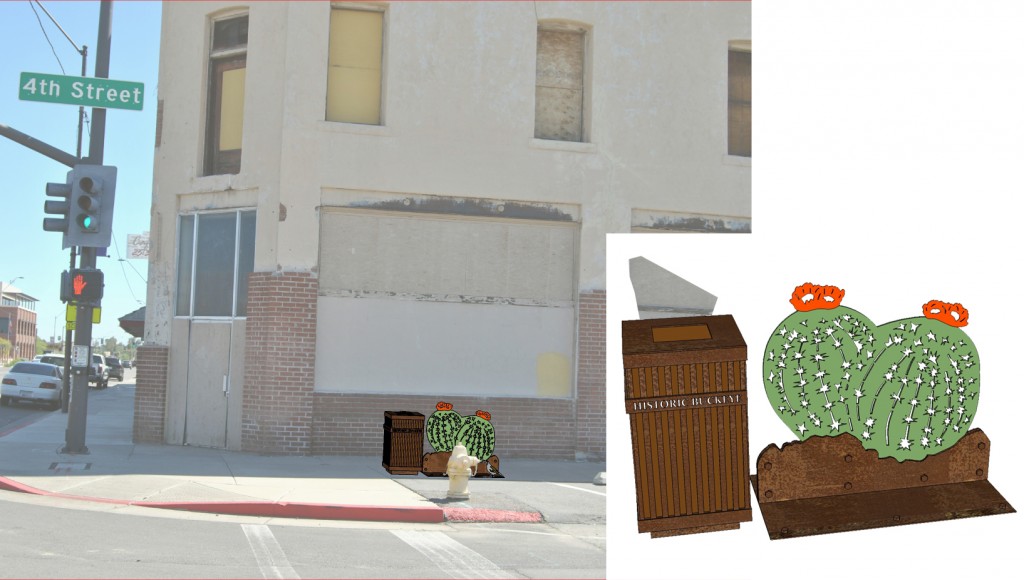
Barrel Cactus located at Southeast corner of Monroe and 4th Street
Looking forward to more Public Art in downtown Buckeye.
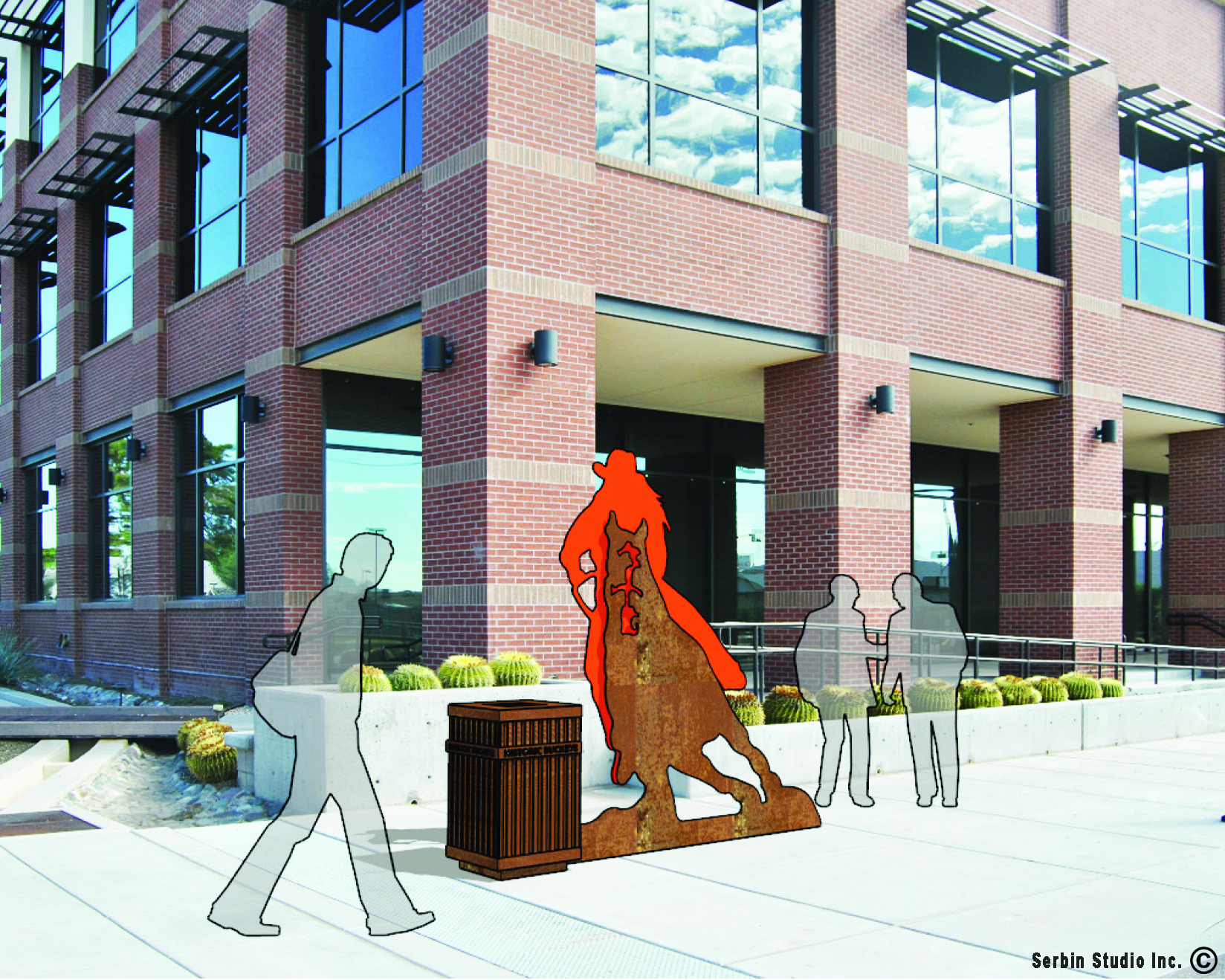
by Jeff Serbin | Mar 9, 2016 | Architecture, Blog, Graphics, Uncategorized
City of Buckeye downtown is growing and becoming more vibrant and a bit of art is on its way. The Buckeye Mainstreet Coalition is working on a project to incorporate art to the Historic Downtown. The art also incorporates trash receptacles. We have seen adding trash receptacles has cleaned up areas of the downtown as evident at Benbow Park. The sculptures are located along Monroe near 6th street.
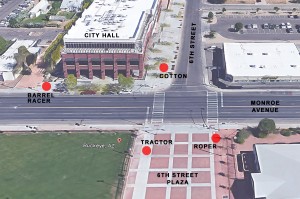
Buckeye Public Art Aerial
With the collaboration of many folks, Charlene Powers of Powers Leavitt Insurance, a longtime resident, local business owner and Buckeye Coalition Board Member for the initial concept, Lara Serbin of Serbin Studio, Design Chair for the Buckeye Coalition, for the design, detailing, permitting and project coordination. Hondo Jimenez from the Buckeye Union High School to assist on constructability and ultimately fabrication and installation of the steel sculptures using local High School talent. The local corrections facility for the design and fabrication of the trash receptacles. The City of Buckeye for providing a portion of the funding through the Economic Development Catalyst Grant Program.
The project consists of 4 sculptures of varying sizes and colors. They are constructed of 3/8″ thick steel. Portions will be allowed to have a rust patina finish while other pieces will be powder coated. They will be permanently anchored into new concrete footings around city sidewalks.
TRACTOR
The largest piece is a tractor to symbolize the influence of farming upon the local community. A great photo opportunity is coming so get your cameras ready. It will stand over 8′ tall and have a powder coated green finish to reflect the influence of John Deere tractors.
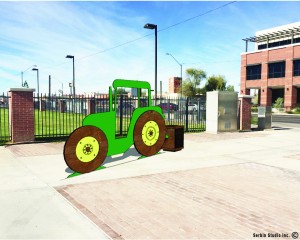
Buckeye Public Art Tractor
BARREL RACER
If you have been to a Buckeye Rodeo, you will have seen the NASCAR of horse racing. Women race around barrels on horseback as fast as the equine can take them without knocking the barrel’s over. This sculpture symbolizes a cowgirl racing around City Hall and incorporates the City of Buckeye ‘Orange’ into the sculpture.
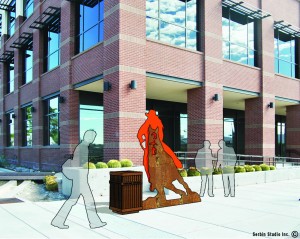
Buckeye Public Art Barrel Racer
ROPER
At rodeo’s and farms across Buckeye, roping can be seen to round up the stray cattle upon the ranch. This sculpture symbolizes the work of the cowboy wrangling up the trash in Downtown Buckeye.
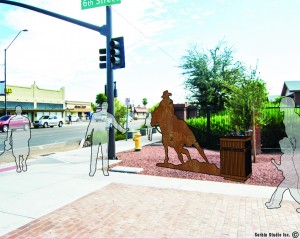
Buckeye Public Art Roper
COTTON
Cotton has been grown in the Buckeye Valley since the early 1900’s. This cotton boll, yet larger than life, symbolizes this important industry which helped put Buckeye on the map.
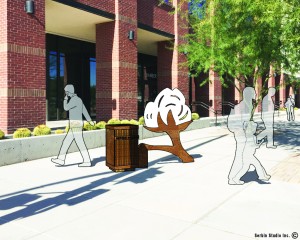
Buckeye Public Art Cotton Boll
This project is just the beginning for more art to be interwoven into the Historic Buckeye fabric. The project is to be completed by early summer of 2016.

by Lara Serbin | Aug 12, 2014 | Architectural Planning, Architecture, Blog, Collaboration, Graphics, Interiors, Planning, Uncategorized
When designing anything it must be functional and meaningful. The photo below is a stop shot. That’s when I make whoever is driving stop the car so I can take a photo. The architect probably used this 1960’s CMU pattern on many of their buildings back in the day. But someone creative added the sweet colors so it caught my eye. Is it meaningful? Yes, it keeps the rain out of the inside of the building and heavily armed knights charging the wall with x-calibers.
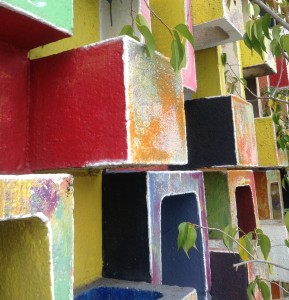
It is easy to get caught up in design especially architecture and forget that people are actually going to use your design after you leave your new building or whatever you designed. The photos below are from the Peterson Automotive Museum in Los Angeles. I like this exhibit because it reminds the visitor of playing with cars. I always like when collections of any kind are showcased. To make it more meaningful and fun they could design a ramp and let you race cars. The orange track has the cars permanently mounted. Cool but too static and boring.
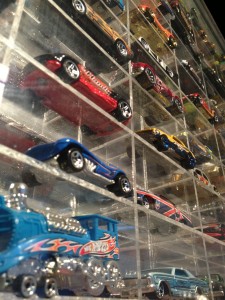
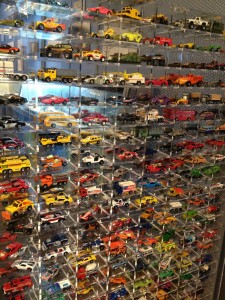
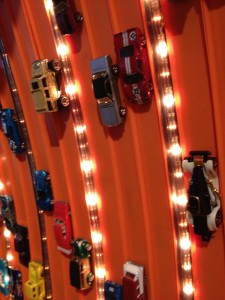
You need to look at the problem from a different angle or a different outfit. Stepping back is a good way to do this. Changing into flip flops and shorts could work too. Ask a friend for their perspective.
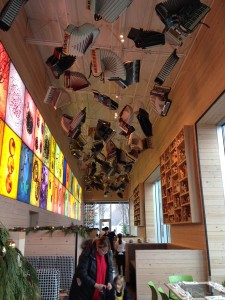
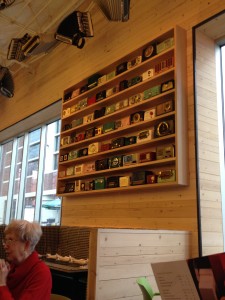
The Collections Cafe in Seattle is a great example of meaningful design. Forgive me for not listing the designer, whoever you are… Can I be you? You rock! Suspended accordions, vintage transistor radios, and creepy yard sale poodle statues are all part of Dale Chihuly’s private collection. Hence the name of the Cafe. Crazy I know! It was a sequential understanding of one artist’s work. First you start in the dark gallery where the glass art is the main focus. Then you have lunch at this cozy cafe and absorb visual clues of Chihuly’s inspirations for his work. I could imagine him looking around at flea markets in hopes of finding another fishing lure for his extensive collection.
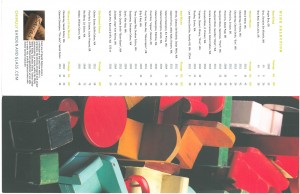
The menu design is wonderful too with a continuation of shapes and color. The whole design package is a design win!
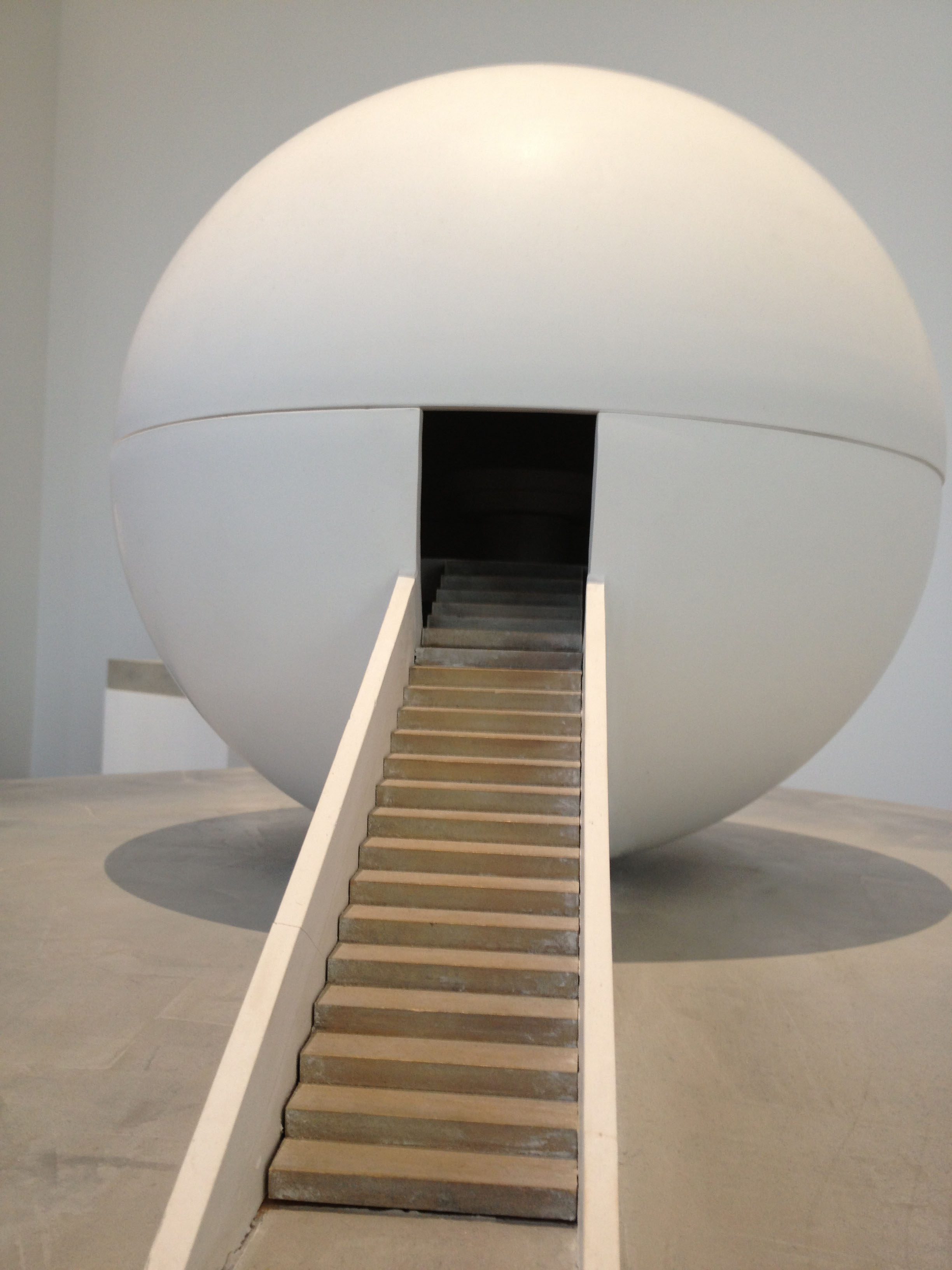
by Lara Serbin | Jul 24, 2013 | Architecture, Blog
The trip to Los Angeles was mostly to see the Retrospective show on James Turrell at the Los Angeles County Museum of Art. I was attracted to the show mainly to experience the hype in Light, Action, The alternate realities of James Turrell by Wil. S. Hylton in the June 16, 2013 New York Times Magazine. Jeffrey has a thing for lighting so I thought it would be fun. A very wise architect told me I needed to know about James Turrell. There are actually 3 different shows in 3 separate museums that Turrell is taking on. The LACMA pieces are obviously ongoing but I am pretty sure he is in Texas for another huge installation at the Museum of Fine Arts, Houston, and then to Manhattan, where is opening a show the Guggenheim. I cherished my tickets I had bought a month earlier, the show was sold out the day I was there.
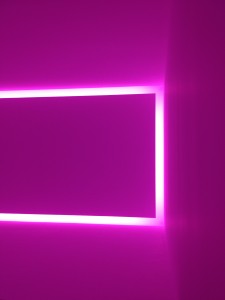
Shallow Space, LACMA, James Turrell
Part I
The best way to take in James Turrell is slowly. There were docents in each of the rooms so security was tight. When I went into the Shallow Space room I was blown away by hot pink light that penetrated my senses. I appreciated Turrell’s finely crafted white plaster benches that folded into the walls like soft whipped meringue. Nothing was left to chance in these tightly organized rooms. Everyone was mostly hushed which was nice. Once I sat for about 12 minutes in Shallow Space the pink light did start to turn whiter. After I was busted for taking the above photo I left Shallow Space and into Cross Corner Construction. My eyes had been conditioned, everything including the walls was avocado green with another hologram in the corner. We asked the docent if the walls were painted green, she said, “No, they are white.” Eventually the green faded to the white plaster. Turrell is clever to play with complimentary colors.
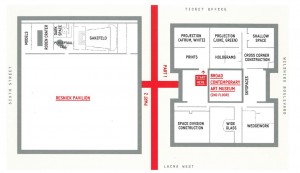
I know this diagram is small. You can enlarge it by clicking on it. This is the floor plan for the exhibit room.
Part II
Naturally I was curious about the Perceptual Cell, the climax of the show and booked solid until January of 2014. The Perceptual Cell is a hollow globe about the size of an SUV. There is a cut out for a drawer about 18 inches by 30 inches. When the drawer is pushed out it is about 6 feet long. There are black carpeted steps up to the drawer with 2 clinical chic docents that facilitate the viewer in laying down on their back in the drawer. I watched the viewer get pushed into the globe. There is a panic button for the viewer inside and a dime sized lookout for the docent. I asked one of the docents what he thought of the Perceptual Cell. He said it was like his eyeball had become one with something like a planetarium Pink Floyd light show. At one point the strobes and lasers were getting so intense he shut his eyes. He went on to say even with closed eyes and using his arm as a shield, he could still see the strobing lights.
Model study found at A Retrospective James Turrell, LACMA. Kind of reminds me of the Perceptual Cell.
Dark Space was awesome. In this exhibit I was instructed to hold onto the wall railing and walk down a dark hallway that had 2 bends in it to black out the light from the waiting area. With each 90 degree turn it got darker. I held onto Jeffrey’s shirt so I wouldn’t run into a wall. Once we got to the end it was a matter of feeling my way to the fixed seating. I was giggling because it was so ridicoulsly dark that I felt out of control and a little freaked out. I thought some dragon was going to come up and breath fire on me or something. I was instructed to just look ahead. It was nice to have Jeffrey there on the other stool to say, “Hey, did you see that? While sitting for the required 15 minutes very weird things started to happen. For one, I had to intentionally blink because I didn’t believe my eyes were open in the blackness, but they were open. It was the same blackness with my eyes closed as it was with my eyes open. I could visually feel my brain trying to find what it needed to see. It didn’t take long for a soft peach light to appear, trust me…Jeffrey saw it too. The peach light would flutter a bit like a fuzzy distant apparition trying to complete itself. For me, the apparition was trying to complete itself but the darkness kept clipping the sides. As I emerged from the darkness, the light in the sanctuary was blinding! I spoke with another docent about other viewers experiences in Dark Space. She heard all kinds of crazy stories of course. They probably saw Elvis. I asked her if there was indeed a soft peach light source in the room and she said no. She said that the only thing that was in the room was a painted circle of white on the far back viewing wall which is in complete darkness. It was awesome to watch my eye and brain work at perceiving something that wasn’t there. Or was it?
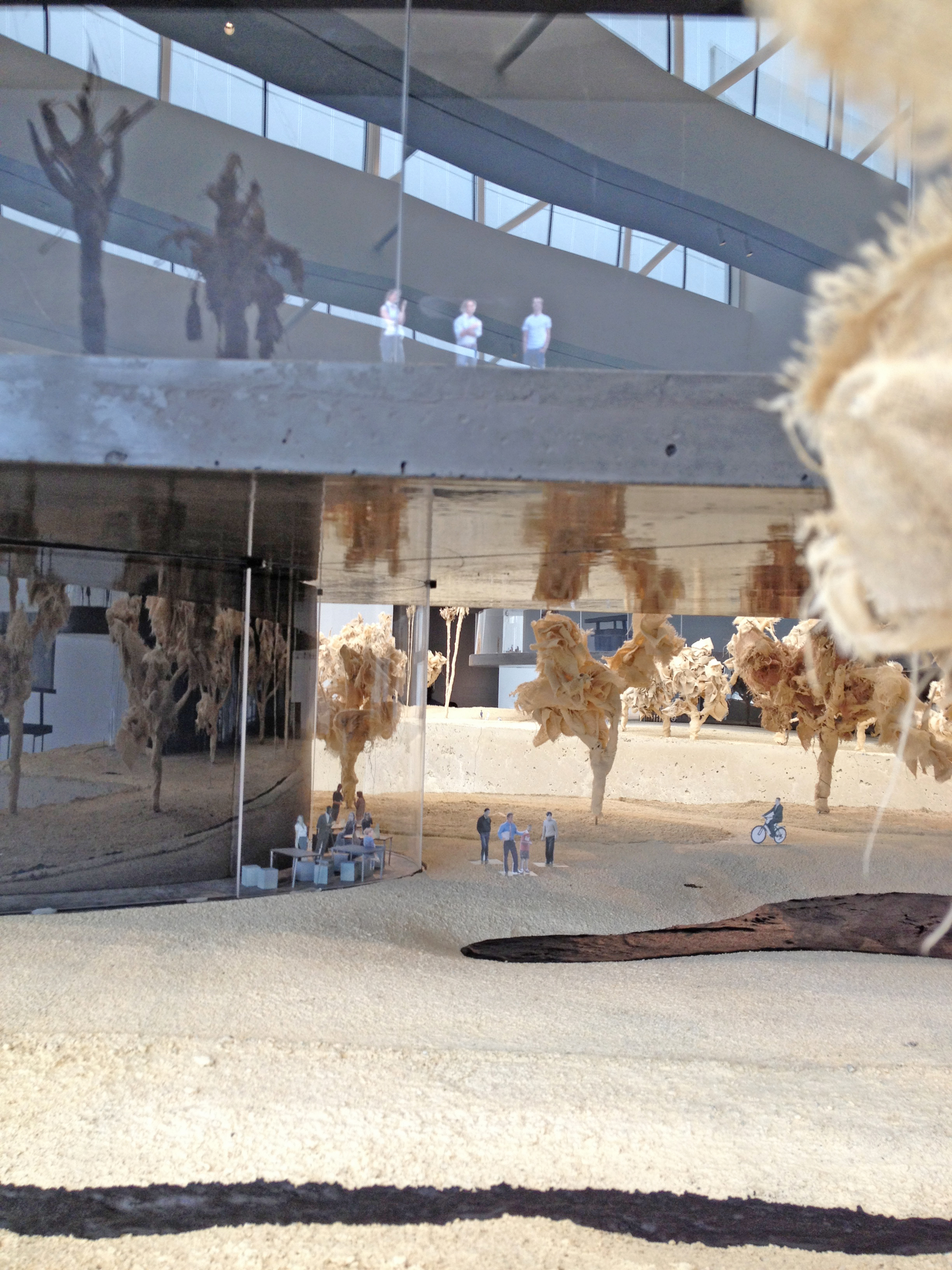
by Lara Serbin | Jul 13, 2013 | Architecture, Blog
Yesterday I had the privilege of visiting the Los Angeles County Museum of Art to see James Turrell a retrospective. Turrell is really wonderful but I will save that for another post. What blew my mind was the fantastic architectural models done by the Swiss architect Peter Zumthor. He seems like such an approachable architect, so down to earth. I guess that is why his work is on display here at LACMA. This is a quote that I read off the wall at the exhibit: It is an organic shape, like a water lily, floating and open with 360 degrees of glass facing Hancock Park, the La Brea Tar Pits, Wilshire Boulevard, Chris Burden’s Urban Light, and Renzo Piano’s new galleries. Primary circulation is achieved by this curving perimeter – a continuous veranda rather than a classical Beaux-Arts spine. Visitors can look out; those outside can look in. From the ground, and in elevation, the museum is mostly transparent. – Peter Zumthor
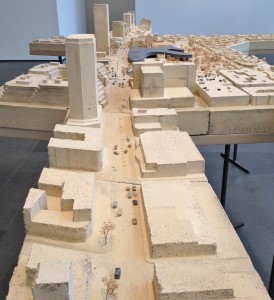
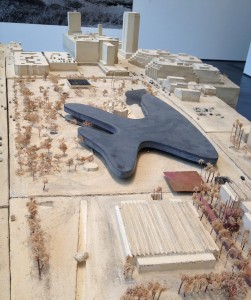
I still can’t get over the base of this site model, the entire base is cast in a concrete plaster mixture. Zumthor must have cast the buildings upside down in a mold. The street names are even cast in the mix. So the black amoeba looking thing is the proposed new museum for LACMA. As far as I understand the design still needs to be approved by the board of the directors, the new building will require the removal of several older structures by other architects. The older buildings are disconnected from one another. When I first read about this project back in Arizona I couldn’t realize the magnitude of it. It wasn’t until I walked the grounds of the LACMA, smelled the bubbling tar pits and felt disconnected by having to go in and out of buildings to see exhibits.
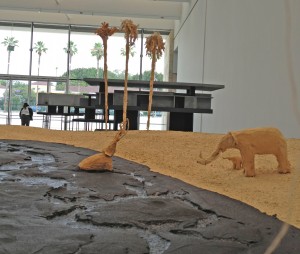
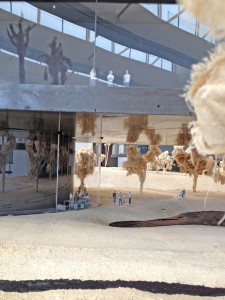
I love the tar pits as shown in the models. The trees on the bigger scale model are tattered muslin on sticks. One of the blob protrusions of the black blob will cantilever over the La Brea Tar Pit. That will be totally cool. As it is now, the tar pits are pretty disconnected from the LACMA experience. I think the older museum buildings are just creepy and dark as well. Getting back to the models, the large scale model of the actual new building is so huge I couldn’t capture it with my Iphone. The photo above on the right is just a snap of what it will be like to see through the glass walls that will be 360 around the entire structure. Of course common sense asks how this big flat black roof will drain and what the sea of proposed solar panels will look like.
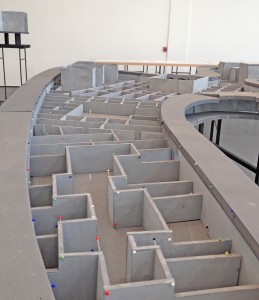
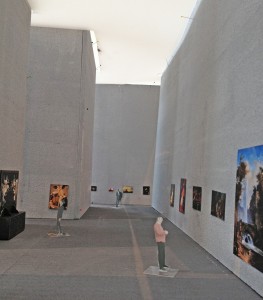
This is a working model on the left. I say working model because of the pins that are holding up the walls. It is supposed to be the largest museum in any city. There are lots of questions in my mind about how storage will work and especially egress. I know at the Phoenix Art Museum there is one main entry and it is highly supervised. I can’t imagine how much it would cost to have 3 museum main entries that Zumthor is proposing for this project. The photo on the right is a study model of light quality for a gallery space. All he did was put a piece of vellum on top of the foam core walls. Museum spaces will not have ambient light if there is a big black flower for a roof?
I enjoyed the models immensely! I am excited to watch this project play out. It is encouraging to know that Zumthor has already been at this project for 6 years and it has not yet been accepted. Zumthor is an inspiration for me in that he comes from a quiet country place in Switzerland and he came to Los Angeles to design an exciting forward looking work of art. He has taken his time to get familiar with Los Angeles and it paid off. I want this black flower to bloom over Los Angeles.





























